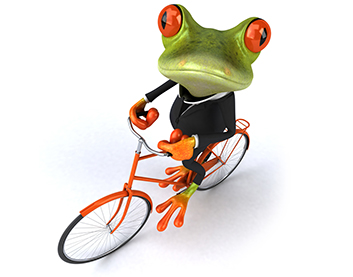Insights
How can you develop organisation culture?
- 20 March 2016
Consider your culture like a frog, not a bicycle. No, really!
After years and years talking about organisation culture, it still seems we all still find it hard to understand. Despite numerous tools and surveys developed, I find that organisations and leaders still struggle to define, then effectively change their company culture.
As observed by Alastair Mant in one of my favourite metaphors of all time, the first step of understanding is seeing how our organisations are like frogs, not bikes:
“You can take a bicycle to pieces and then reassemble the whole thing confident that it will work the same as before. The frog is different. Once you remove a single part of a frog, you influence the capacity of every other part of the animal to play its part in system survival. But because frogs have adaptive properties, you can go on removing bits (downsizing, outsourcing, privatising) for a surprising length of time - until you finally remove one part too many - at which point your frog will tip over into irrecoverability. It won’t help to sew bits back on.”
Organisations are living and breathing human systems. They come with all the vagaries, complexities, and idiosyncrasies that come with being human (or frog!). To change a person’s underlying beliefs and motivations is a very tricky, slow, non-linear process.
So it is too with organisation culture.
An organisation’s culture is shaped by continual interchange with the operating environment, and layered with all the complex skills and learned behaviours of people. We can experience culture, pay attention to it, and interact with it. By doing so – consciously and collectively over time – we develop and shape it.
In light of this understanding: What can we do to help develop and shape organisation culture?
1. Define
Work out what sort of culture is going to set your organisation up for success in its environment. Define your critical levers and think of conversations, examples, and stories that describe the very core of your business, such as:
- Where business is won or lost
- When customers are delighted or infuriated
- How products are made efficiently, or cast off as wastage
2. Align
Then look at the behaviours, symbols, systems and practices that will help or hinder these critical levers. Make changes in these areas to start aligning your organisation culture. Focus particularly on the ‘local’ level, where the core work of your organisation happens.
3. Sustain
Finally, do what is needed to sustain your culture (and I don’t mean keep it as it is!). What practices are needed to keep it ‘generative’ in nature? How open and adaptive is it to changes in your environment, and how skilled is it at really seeing and hearing what needs to shift? As Derek Irvine says, how much can organisations leverage the power of difference to enable cultural contribution?
Through the process of Defining, Aligning, and Sustaining, organisations will of course naturally continue to ‘re-define’ culture. This takes us back to the beginning, but rather than a prescribed and reductionist regime, organisation culture is now defined now in a natural and cyclical way.
Do you treat your organisation culture like a bicycle, or like a frog? How do you define, align, and sustain your organisation’s culture?
Throughout 2016 at LTA, we’ll be talking a lot more about Culture, Capability, and Connection, and how these help people and organisations to bring their best. Watch our LinkedIn updates for our website and blog relaunch April 2016.


